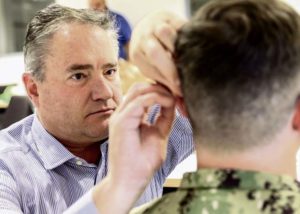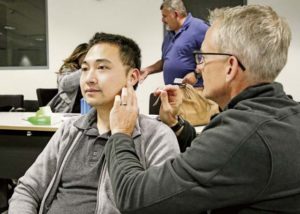by Marcy Sanchez
Landstuhl Regional Medical Center

For centuries, head injuries have been a consequence of war and violence, sometimes leading to unexplained physical and behavioral changes in patients. Landstuhl Regional Medical Center’s Traumatic Brain Injury and Rehabilitation Clinic hosted medical professionals during a three-day TBI Champion Training Conference at Ramstein Air Base, to standardize TBI clinical care by sharing knowledge, current recommendations and best practices.
According to the Defense and Veterans Brain Injury Center, a TBI is a blow or jolt to the head that disrupts the normal function of the brain. Severity is determined at the time of the injury and may be classified as mild, moderate or severe. Since 2000, more than 380,000 service members have sustained a TBI from various activities ranging from military training and sports activities to combat.
“The goal was to bring medical providers, nurses, and medics here and share TBI information with them,” said Casey Becker, DVBIC regional education coordinator at LRMC. “We discussed TBI and why it’s important in the military, the new information coming out about TBI, and acute concussion management so they can take it back to their clinics and share with their colleagues to standardize that TBI care.”
The platform also introduced medical professionals to the most recent head injury assessment tool, the Military Acute Concussion Evaluation (MACE 2), a multimodal tool assisting providers in the assessment and diagnosis of concussion. The tool’s effectiveness immediately after the time of injury can help medical professionals determine the severity of the concussion and the steps to take to optimize care, thereby increasing medical readiness for the combatant commands.
“Many people [at this conference] would be identified as the first person to see (potential TBI patients) in an emergency room, primary care clinic or urgent care clinic,” said U.S. Air Force Capt. Philip Oro, family medicine physician, 86th Medical Group, Ramstein Air Base. “In (medical school) we learn to look at patients and determine sick versus not sick and that seems very black and white. The environment of learning in the last three days gave us what we needed to watch for and disposition patients to a higher level of care if needed.”
Individuals between the ages of 18 to 24 are at the greatest risk for TBI since they are more likely to engage in high-risk activities, a demographic which represents 45 percent of today’s active-duty force. Common symptoms of mild TBIs include headaches, sleep disturbances, dizziness, balance problems, nausea, fatigue, visual disturbances (blurred vision, double vision), light or noise sensitivity, cognitive changes, and emotional changes. The DVBIC research portfolio includes robust studies examining the effects of brain injury and exposure, as well as ways to support individuals in recovery.

“We’re trying to make sure that all providers in all branches have an understanding of what to do and the resources available,” said Becker, a native of Clinton, Missouri. “Providers are aware that TBIs and acute concussion are prevalent and even though it isn’t in the news it impacts everyone.”
Although combat-related TBIs have been publicized due to the wars in Afghanistan and Iraq, TBI is not uncommon in non-combat environments and can occur during regular daily activities.
The conference included discussions led by TBI experts on acute concussions, mindfulness-based interventions, neuropsychology, management of persistent post-concussive syndromes, sleep disruption, TBI research and future initiatives. Additionally, alternative treatment options were introduced, such as acupuncture for pain management and the role of occupational therapy in TBI rehabilitation. Attendees embodied all aspects of military medicine, including active-duty service members, civilians, and National Guardsmen, representing Department of Defense medical facilities across Europe and Western Asia.
“Last year we were in a base in eastern Turkey where there was nothing around. To talk to a specialist and get that help (for TBI), I had to call LRMC,” said Oro, a Tucson, Arizona, native. “Now having realized the types of resources out there through the conference, what websites are available, the clinical decision-making tools that are out there, it’s just incredibly helpful to do exactly what’s expected of me as a primary care doctor either in the acute or chronic period going forward.”
Oro believes the information gained from the conference will not only help his ability to assess TBI severity, but encourage other medical professionals to utilize these tools to prevent delayed care.
“It’s not just about me and my learning, it’s about me going back to others and making sure they are on the same page. The medic can do point-of-care in the field, (diagnosing) takes 10-15 minutes and they’ll get a full (evaluation to) identify if there are red flags and immediately consult a higher level of care or evacuate the patient if needed,” said Oro. “Help and resources are available. The information will help make sure that the military personnel that I care for are more ready, capable and at their best to complete the mission, and if they’re not, to identify it and get them the right care.”


